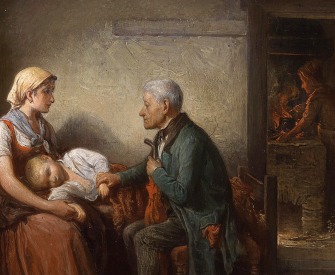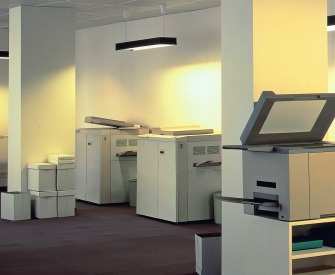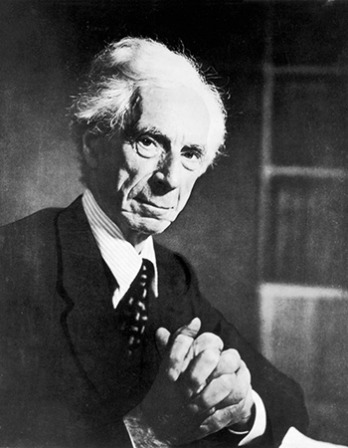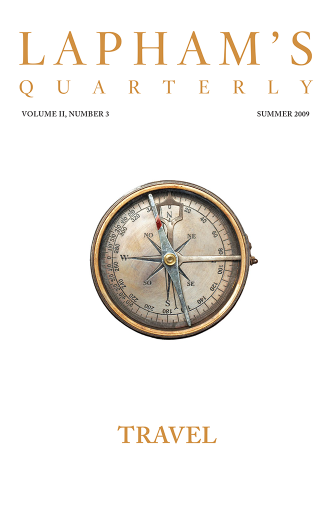The life of spies is to know, not be known.
—George Herbert, 1621Happy All the Time
As biometric tracking takes over the modern workplace, the old game of labor surveillance is finding new forms.
By Lynn Stuart Parramore
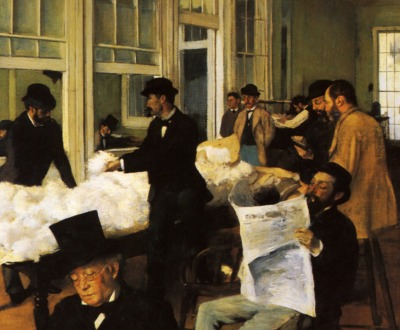
A Cotton Office in New Orleans, by Edgar Degas, 1873. Musee des Beaux-Arts.
Call them soldiers, call them monks, call them machines: so they were but happy ones, I should not care.
—Jeremy Bentham, 1787
Housed in a triumph of architectural transparency in Cambridge, Massachusetts, is the Media Lab complex at MIT, a global hub of human-machine research. From the outside of its newest construction, you can see clear through the building. Inside are open workspaces, glittering glass walls, and screens, all encouragement for researchers to peek in on one another. Everybody always gets to observe everybody else.
Here, computational social scientist Alex Pentland, known in the tech world as the godfather of wearables, directs a team that has created technology applied in Google Glass, smart watches, and other electronic or computerized devices you can wear or strap to your person. In Pentland’s quest to reshape society by tracking human behavior with software algorithms, he has discovered you don’t need to look through a glass window to find out what a person is up to. A wearable device can trace subliminal signals in a person’s tone of voice, body language, and interactions. From a distance, you can monitor not only movements and habits; you can begin to surmise thoughts and motivations.
In the mid-2000s Pentland invented the sociometric badge, which looks like an ID card and tracks and analyzes the wearer’s interactions, behavior patterns, and productivity. It became immediately clear that the technology would appeal to those interested in a more hierarchical kind of oversight than that enjoyed by the gurus of MIT’s high-tech playgrounds. In 2010 Pentland cofounded Humanyze, a company that offers employers the chance to find out how employee behavior affects their business. It works like this: A badge hanging from your neck embedded with microphones, accelerometers, infrared sensors, and a Bluetooth connection collects data every sixteen milliseconds, tracking such matters as how far you lean back in your chair, how often you participate in meetings, and what kind of conversationalist you are. Each day, four gigabytes’ worth of information about your office behavior is compiled and analyzed by Humanyze. This data, which then is delivered to your supervisor, reveals patterns that supposedly correlate with employee productivity.

Discovery of Achilles on Skyros, by Nicolas Poussin, c. 1649. © Museum of Fine Arts, Boston / Juliana Cheney Edwards Collection / Bridgeman Images.
Humanyze CEO Ben Waber, a former student of Pentland’s, has claimed to take his cues from the world of sports, where “smart clothes” are used to measure the mechanics of a pitcher’s throw or the launch of a skater’s leap. He is determined to usher in a new era of “Moneyball for business,” a nod to baseball executive Billy Beane, whose data-driven approach gave his team, the Oakland Athletics, a competitive edge. With fine-grained biological data points, Waber promises to show how top office performers behave—what happy, productive workers do.
Bank of America hired Humanyze to use sociometric badges to study activity at the bank’s call centers, which employ more than ten thousand souls in the United States alone. By scrutinizing how workers communicated with one another during breaks, analysts came to the conclusion that allowing people to break together, rather than in shifts, reduced stress. This was indicated by voice patterns picked up by the badge, processed by the technology, and reported on an analyst’s screen. Employees grew happier. Turnover decreased.
The executives at Humanyze emphasize that minute behavior monitoring keeps people content. So far, the company has focused on loaning the badges to clients for limited study periods, but as Humanyze scales up, corporate customers may soon be able to use their own in-house analysts and deploy the badges around the clock.
Workers of the world can be happy all the time.
The optimists’ claim: technologies that monitor every possible dimension of biological activity can create faster, safer, and more efficient workplaces, full of employees whose behavior can be altered in accordance with company goals.
Widespread implementation is already underway. Tesco employees stock shelves with greater speed when they wear armbands that register their rate of activity. Military squad leaders are able to drill soldiers toward peak performance with the use of skin patches that measure vital signs. On Wall Street, experiments are ongoing to monitor the hormones of stock traders, the better to encourage profitable trades. According to cloud-computing company Rackspace, which conducted a survey in 2013 of four thousand people in the United States and United Kingdom, 6 percent of businesses provide wearable devices for workers. A third of the respondents expressed readiness to wear such devices, which are most commonly wrist- or head-mounted, if requested to do so.
Biological scrutiny is destined to expand far beyond on-the-job performance. Workers of the future may look forward to pre-employment genetic testing, allowing a business to sort potential employees based on disposition toward anything from post-traumatic stress disorder to altitude sickness. Wellness programs will give employers reams of information on exercise habits, tobacco use, cholesterol levels, blood pressure, and body mass index. Even the monitoring of brain signals may become an office commonplace: at IBM, researchers bankrolled by the military are working on functional magnetic-resonance imaging, or fMRI, a technology that can render certain brain activities into composite images, turning thoughts into fuzzy external pictures. Such technology is already being used in business to divine customer preferences and detect lies. In 2006 a San Diego start-up called No Lie MRI expressed plans to begin marketing the brain-scanning technology to employers, highlighting its usefulness for employee screening. And in Japan, researchers at ATR Computational Neuroscience Laboratories have a dream-reading device in the pipeline that they claim can predict what a person visualizes during sleep. Ryan Hurd, who serves on the board of the International Association for the Study of Dreams, says such conditioning could be used to enhance performance. While unconscious, athletes could continue to practice; creative types could boost their imaginations.
The masterminds at Humanyze have grasped a fundamental truth about surveillance: a person watched is a person transformed. The man who invented the panopticon—a circular building with a central inspection tower that has a view of everything around it—gleaned this, too. But contrary to most discussions of the “all-seeing place,” the idea was conceived not for the prison, but for the factory.
Jeremy Bentham is usually credited with the idea of the panopticon, but it was his younger brother, Samuel Bentham, who saw the promise of panoptical observation in the 1780s while in the service of Grigory Potemkin, a Russian officer and statesman. Potemkin, mostly remembered for creating fake villages to fool his lover, Catherine the Great, was in a quandary: his factories, which churned out everything from brandy to sailcloth, were a hot managerial mess. He turned to Samuel, a naval engineer whose inventions for Potemkin also included the Imperial Vermicular, a wormlike, segmented 250-foot barge that could navigate sinuous rivers. Samuel summoned skilled craftsmen from Britain and set them to the hopeless task of overseeing a refractory mass of unskilled peasant laborers who cursed and fought in a babel of languages. Determined to win Potemkin’s favor, he hit on a plan for a workshop at a factory in Krichev that would allow a person, or persons, to view the entire operation from a central inspector’s lodge “in the twinkling of an eye,” as his brother Jeremy would later write in a letter. The inspector could at once evoke the omnipresence of God and the traditional Russian noble surrounded by his peasants. Laborers who felt themselves to be under the constant eye of the inspector would give up their drunken brawls and wife-swapping in favor of work.
War thwarted Samuel’s plans for the Krichev factory, eventually forcing him to return home to Britain, where, in 1797, he drew up a second panoptical scheme, a workhouse for paupers. Six years earlier, in 1791, Jeremy had borrowed Samuel’s idea to publish a work on the panoptical prison, built so that guards could see all of the inmates while the latter could only presume they were being watched, fostering “the sentiment of a sort of omnipresence” and “a new mode of obtaining power of mind over mind.” In America, the Society for Alleviating the Miseries of Public Prisons adopted panoptical elements for the Eastern State Penitentiary in Philadelphia, adding solitary confinement with the idea of delivering the maximum opportunity for prisoner repentance and rehabilitation. Visiting the prison in 1842, Charles Dickens noted that its chief effect on inmates was to drive them insane.
Before the days of industrialization, employers had little use for surveillance schemes. The master craftsman lived in his workshop, and his five to ten apprentices, journeymen, and hirelings occupied the same building or adjacent cottages, taking their behavioral cues from his patriarchal authority. The blacksmith or master builder or shoemaker interacted with his underlings in a sociable and informal atmosphere, taking meals with them, playing cards, even tippling rum and cider. Large-scale manufacturing swept this all away. Workmen left the homes of their employers; by the early decades of the nineteenth century, the family-centered workplace—where employers provided models of behavior, food, and lodging—was becoming a thing of memory.
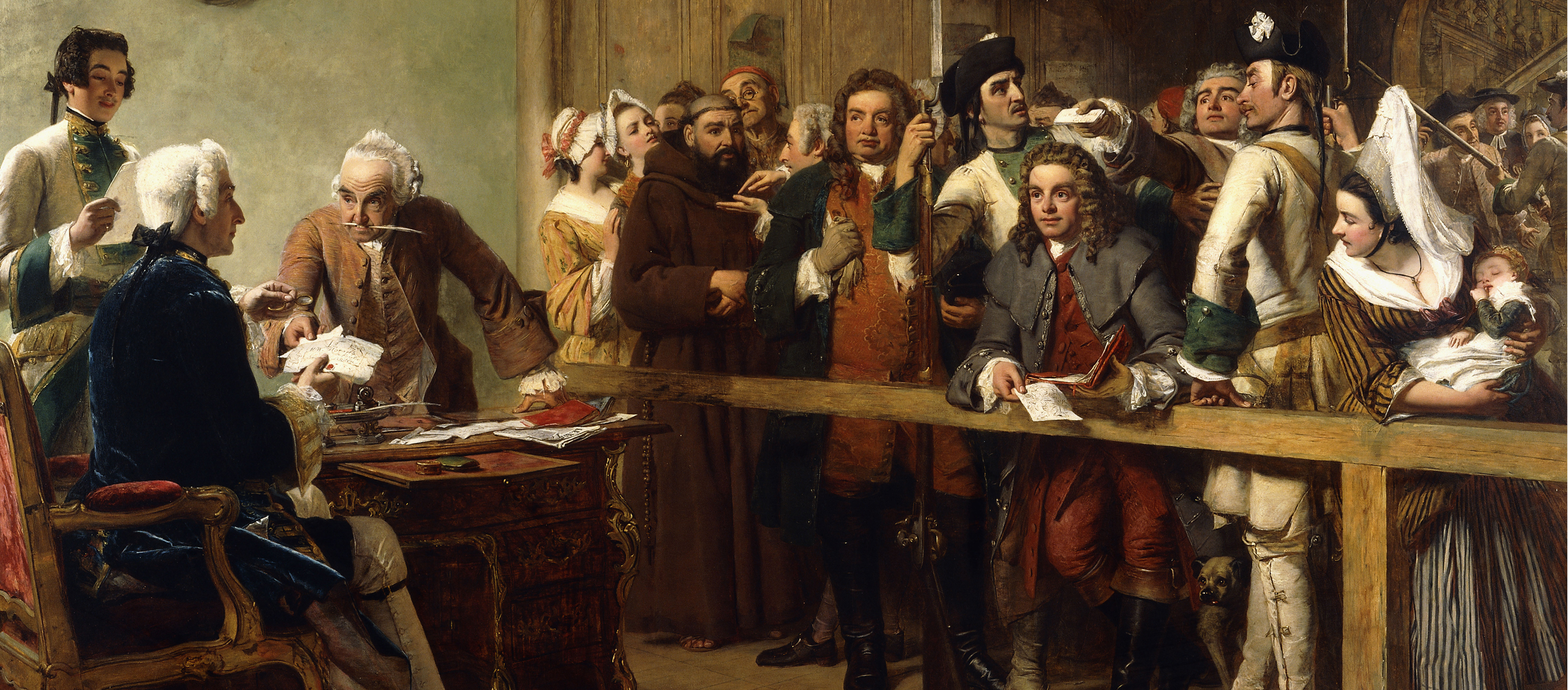
Hogarth Brought Before the Governor of Calais as a Spy, by William Powell Frith, 1851. Bridgeman Images.
Proto-industrialists found that their new employees, an ever-shifting mass of migrants and dislocated farm boys, found ample opportunities for on-the-job drunkenness, inattention, and fractious behavior. In his classic work A Shopkeeper’s Millennium, historian Paul E. Johnson observes that in America an answer to this problem was found in the Protestant temperance movement just then blowing righteous winds across the Northeast. Managers found that the revival and the Sunday school could foster strict internal values that made constant supervision less important. Workers, if properly evangelized, would turn willingly from the bottle to the grueling business of tending power-driven machines. God would do the monitoring as He does it best—from the inside.
Unfortunately, God’s providential eye tended to blink in the absence of regular churchgoing. So in the 1880s and 1890s, mechanical engineer Frederick Winslow Taylor displaced God with scientific management systems, devising precise methods of judging and measuring workers to ensure uniformity of behavior and enhanced efficiency. Taylor’s zeal to scrutinize every aspect of work in the factory led to such inventions as a keystroke monitor that could measure the speed of a typist’s fingers. His methods of identifying underperforming cogs in the industrial machine became so popular that Joseph Wharton, owner of Bethlehem Steel, incorporated Taylor’s theories into the bachelor’s degree program in business he had founded at the University of Pennsylvania. Harvard University soon created a new master’s degree in business administration, the MBA, that focused on studying Taylorism.
Workplace surveillance didn’t evolve much beyond Taylor’s ideas until closed-circuit television brought prying to heights unimagined by the brothers Bentham. In 1990 the Olivetti Research Laboratory, in partnership with the University of Cambridge Computer Laboratory, announced an exciting new workplace-spying project aptly named Pandora. The Pandora’s Box processor handled video streams and controlled real-time data paths that allowed supervisors to peek in on remote workstations. An improved system launched in 1995 was named Medusa, after the Greek monster who turned victims to stone with her gaze.
By the early twenty-first century, electronic monitoring in the workplace became de facto, with bosses peering into emails, computer files, and browser histories. From the lowest-rung laborers to the top of the ivory tower, no employee was safe. In 2013 Harvard University was found to have snooped in the email accounts of sixteen faculty deans for the source of a media leak during a cheating scandal. Global positioning systems using satellite technology, which came to maturity by 1994 and grew popular for tracking delivery trucks, opened new methods of watching. Dennis Gray, owner of Accurid Pest Solutions, could satisfy a hunch in 2013 that workers were straying from their tasks. He quietly installed GPS tracking software on the company-issued smartphones of five of its drivers; one indeed was found to be meeting up with a woman during work hours. In 2015 Myrna Arias, a sales executive for money-transfer service Intermex, objected to her employer monitoring her personal time and turned off the GPS device that tracked her around the clock. She was fired.
Secrets define us, they mark us, they set us apart from all the others. The secrets which we preserve provide a key to who we are, deep down.
—Nuruddin Farah, 1998Surveillance technology stirs up profound questions as to who may observe whom, under what conditions, for how long, and for what purpose. The argument for monitoring the vital signs of an airline pilot, whose job routinely holds lives at stake, may seem compelling, but less so for a part-time grocery store clerk. In a 1986 executive order President Ronald Reagan, expressing concern about the “serious adverse effects” of drug use on the workforce, which resulted in “billions of dollars of lost productivity each year,” instituted mandatory drug testing for all safety-sensitive executive-level and civil-service federal employees. A noble mission, perhaps, but prone to expand like kudzu: by 2006 it entangled up to three out of four jobseekers, from would-be Walmart greeters to washroom attendants, who were forced to submit to such degradations as peeing in a plastic jar, sometimes under the watchful eye of a lab employee. Thirty-nine percent could expect random tests after they were hired, as well as dismissal for using substances on or off the job and regardless of whether their use impaired performance. Job applicants often accordingly changed their behavior; one scheme involved ordering dog urine through the mail to fool the bladder inspectors.
At the 2014 Conference on Human Factors in Computing Systems, held in Toronto, participants noticed an unusual sign affixed to restroom doors: behavior at these toilets is being recorded for analysis. It had been placed there by Quantified Toilets (slogan: every day. every time.), whose mission, posted on its website, states: “We analyze the biological waste process of buildings to make better spaces and happier people.” At the conference, Quantified Toilets was able to provide a real-time feed of analytical results. These piss prophets of the new millennium could tell if participants were pregnant, whether or not they had a sexually transmitted disease, or when they had drugs or alcohol in their system. (One man had showed up with a blood-alcohol level of 0.0072 percent and a case of gonorrhea.)
Quantified Toilets, it turned out, was not a real company, but a thought experiment for the conference, designed to provoke discussion about issues of privacy in a world where every facial expression, utterance, heartbeat, and trip to the bathroom can be captured to generate a biometric profile. Workplace surveillance, after all, is a regulatory Wild West; employees have few rights to privacy on the job. A court order may be necessary for police to track a criminal suspect, but no such niceties prevent an employer from exploring the boundaries of new technologies. History suggests that abuses will be irresistible: in 1988 the Washington, DC, police department admitted using urine tests to screen female employees for pregnancy without their knowledge.

The Hermit and Sleeping Angelica, by Peter Paul Rubens, c. 1628. © Kunsthistorisches Museum, Vienna / Bridgeman Images.
Biosurveillance has strong allies, including its own Washington lobbying firm, the Secure Identity and Biometrics Association, committed to bringing new products to government, commercial, and consumer spheres. The VeriChip, a human-implantable microchip using radio frequency identification, allows scanners in range of the implant to access records and information about a person. It received FDA approval in 2004 (though the company later merged and became PositiveID). In Mexico, eighteen workers at the attorney general’s office were required to have the rice-grain-sized chip injected under their skin to gain access to high-security areas. One anti-RFID crusader has called the technology the “mark of the beast,” as predicted in the Book of Revelation.
In the film Gattaca, set in the not-too-distant future, biometric surveillance is deployed to distinguish between genetically engineered superior humans and genetically natural inferior humans, who are forced to do menial jobs. We are quickly approaching such a world: employers who are able to identify—and create—workers with superior biological profiles are already turning the science fiction into reality.
Humanyze assures in corporate materials that privacy is a top priority. The names of employees are stored separately from behavioral information, and individual conversations aren’t recorded, just the metadata—a distinction familiar to those following the story of the widespread phone-tapping program of the NSA. Still, it requires little imagination to see how employers can use it for more extensive and rigorous surveillance of individual workers. A benign boss in the present may use data to decide the arrangements of break rooms and cubicles to enhance worker satisfaction and, in so doing, improve productivity. But in the future the same data may be retrieved and analyzed for unimagined possibilities. Observation is versatile in its application. In the face of capitalist demands for high performance and efficiency, abstract ideas like privacy and freedom can come to sound quaint and sentimental.
As optic and electronic watching give way to biosurveillance, the architecture of the Bentham brothers’ panopticon melts away and becomes internalized. The self-watching employee, under her own unwavering gaze, pre-adjusts
behavior according to a boss’ desire. Biosurveillance is sold as a tool for boosting happiness, but it also promotes a particular idea of what happiness is—which probably looks a lot more like workers who don’t make trouble than like squeaky wheels or even like the champions of disruption touted in Silicon Valley. The power to make you happy is also the power to define your happiness.
With his mantra “the medium is the message,” Marshall McLuhan stressed that the changes wrought upon us by technology may be more significant than the information revealed by it. Devices that monitor our minds and movements become part of who we are. Back in the Cold War, the Western press routinely derided Communist-bloc news clips of happy workers toiling away, singing songs in the mills and fields. One anti-communist propaganda animation from 1949, Meet King Joe, depicts a Chinese peasant smiling only because he is unaware of the paltriness and restrictions of his conditions. Such promos, perhaps, were just ahead of their time. Modern capitalism is poised to do them one better.
If you read somebody’s diary, you get what you deserve.
—David Sedaris, 2004Despite its name, a company like Humanyze—which brings forth the next frontier of biometric, device-driven surveillance—can make us less ourselves, more like who we’re supposed to be according to objectives of those who track our metrics. When we can feel, even on a cellular level, the gaze of the inspector, the invisible hand becomes the invisible eye, guiding as it does best, from within. Perhaps we will find true what we once feared: that contented workers are all alike. But so long as we are happy, who cares?
